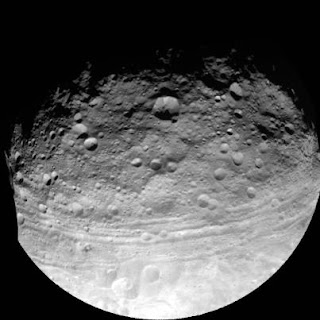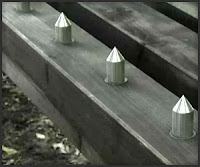Stunted Planet Suggested By Troughs of Asteroid
Since the July 2011 sighting of the extensive troughs that spans the entire breadth of asteroid Vesta, scientists have always been intrigued by through system's enormous size, which is not normal, to say the least. Now, new analysis has suggested that these troughs could have been resulted from another asteroid, when it crash-landed onto South Pole of Vesta. The finding reinforces the belief that Vesta is likely a layered asteroid, a character more closely associated with larger entities, like large moons and planets.
Deformations on the surfaces are typical among the asteroids in our solar system. They are mainly manifested as cracks resulted from crashes that occurred with other various asteroids. What is not common is an extensive troughs system, such as the one encircles Vesta. Vesta itself is huge. In term of mass, it is second only to dwarf planet Ceres in our solar system. And it measures about 1/7th of the Moon in diameter. Just to have an appreciation of its impressive troughs, the largest of them all called Divalia Fossa is bigger than the entire Grand Canyon. The structure spans 465 kilometers long, 22 km wide and 5 km deep.
For long time, the formation of these gigantic troughs has been a puzzle. The natural assumption is that it has been brought about by some really serious collisions. Last year, images transmitted from Dawn spacecraft of NASA were used to study Vesta's topography, and the derivation that a big collision is very likely to be the reason behind it but, on assumption that this asteroid Vesta is differentiated (consisting of crust, mantle and core), which is another way to say that the asteroid has a layered texture. The varying densities across layers caused the earth to slide extensively.
Image [Click to enlarge]
A study by Johns Hopkins University Applied Physics Laboratory published online in Geophysical Research Letters explained that most of the asteroids are generally pretty simple. What makes Vesta stands out is that there are evidences of igneous rock; the strongest hint that Vesta's surface, at one point of time was molten, which further support the theory of differentiation. In the publication, Debra Buczkowski, the head researcher, ventured that these cracks are not just troughs, but graben.
Graben is a land block that is depressed and has parallel faults as its border. Graben is produced when a land block is downthrown and a valley is produced with very distinct scraps on both sides.
What is especially interesting about John Hopkins analysis is that Vesta seems to display characteristics of a planet in the making, in the sense that it has a ductile mantle that can be stretched when sufficiently huge pressure is applied.
The observation has attracted the attention of Geoff Collins planetary scientist specialized in tectonics from Wheaton College, Norton, Mass. Collins said, "On many much smaller asteroid bodies, we've seen very narrow troughs that look just like cracks on the surface. But nothing that looks like a sort of traditional terrestrial graben that you'd find on Mars or the moon where things have really been pulled apart."
Collins is not really convinced that troughs of Vesta are graben. According to him, what appears to be graben on Vesta are possibly craters that are possible torn into two by any rough.
While Buczkowski's graben theory has not won over Collins, she still believes there is still a lot to be learned on how troughs get formed. Vesta unlike larger asteroid Ceres is not considered dwarf planet as it does not resemble a spherical shape (most likely due to the huge impact on Vesta's South Pole as stipulated earlier). But if core and mantle do exist, it would have embodied all characteristics of planets, moons and dwarf planets - no matter what shape it assumes.
But the peculiar shape of Vesta has attracted another hypothesis on the formation of the troughs. Britney Schmidt from Institute for Geophysics, Austin, Texas, feels that South Pole collision is the reason behind the accelerated Vesta's rotation rate of 5.35 hours. This could be responsible for the outward bulge of its equator. She figured the amazing rotational speed forced the equator to bulge or expand outward that could likely contribute to the troughs, instead of powerful impact at South Pole. Schmidt who was not involved in the current study said that Vesta's fast rotation is an enigma.




Comments
Post a Comment